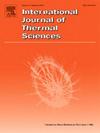Development and application on an unsteady measurement method of heat transfer for aero-engine rotating disk cavity with complex thermal boundary conditions
IF 4.9
2区 工程技术
Q1 ENGINEERING, MECHANICAL
International Journal of Thermal Sciences
Pub Date : 2025-04-11
DOI:10.1016/j.ijthermalsci.2025.109907
引用次数: 0
Abstract
The measurement method of convective heat transfer coefficient is the technical bottlenecks in carrying out the current thermal analysis and refined design of rotating disk cavity. In order to measure the convective heat transfer coefficient of rotating disk with high rotational speed under complex thermal boundary conditions, this paper proposes a new strategy for acquiring convective heat transfer coefficient by combination with experimental data and numerical calculation of unsteady thermal conductivity in the solid domain. The convective heat transfer coefficient is indirectly obtained at the corresponding position by predicting heat flux through the loading of transient temperature field of solid surface measured in the experiment. Moreover, the effects of Fourier number and measurement random errors on the accuracy of the measurement method during unsteady heat transfer are investigated. The results show that the uncertainty of the convective heat transfer coefficient corresponding to the measurement method is less than 8.20 % when the measurement error is considered. Asymmetric flat plate heat transfer experiments are also carried out. The experimental results show that the deviation of the experimental results from the empirical correlation formula in the range of mass flow rate from 200 g/s to 400 g/s is less than 8 %, which proves that the measurement method can accurately measure the convective heat transfer coefficient under the asymmetric thermal boundary conditions. This paper provides a new convective heat transfer coefficient measurement technique for subsequent rotating disk cavity heat transfer experiments under complex thermal boundary conditions.

复杂热边界条件下航空发动机转盘腔换热非定常测量方法的开发与应用
对流换热系数的测量方法是当前进行旋转盘腔热分析和精细化设计的技术瓶颈。为了测量复杂热边界条件下高速旋转圆盘的对流换热系数,本文结合实验数据和固体区域非定常导热系数的数值计算,提出了一种新的对流换热系数获取策略。通过实验中实测的固体表面瞬态温度场的加载来预测热流密度,从而间接得到相应位置的对流换热系数。此外,还研究了非定常换热过程中傅里叶数和测量随机误差对测量方法精度的影响。结果表明,在考虑测量误差的情况下,该测量方法对应的对流换热系数的不确定度小于8.20%。进行了非对称平板换热实验。实验结果表明,在质量流量为200 g/s ~ 400 g/s范围内,实验结果与经验相关公式的偏差小于8%,证明了该测量方法可以准确测量非对称热边界条件下的对流换热系数。本文为后续复杂热边界条件下的旋转盘腔换热实验提供了一种新的对流换热系数测量技术。
本文章由计算机程序翻译,如有差异,请以英文原文为准。
求助全文
约1分钟内获得全文
求助全文
来源期刊

International Journal of Thermal Sciences
工程技术-工程:机械
CiteScore
8.10
自引率
11.10%
发文量
531
审稿时长
55 days
期刊介绍:
The International Journal of Thermal Sciences is a journal devoted to the publication of fundamental studies on the physics of transfer processes in general, with an emphasis on thermal aspects and also applied research on various processes, energy systems and the environment. Articles are published in English and French, and are subject to peer review.
The fundamental subjects considered within the scope of the journal are:
* Heat and relevant mass transfer at all scales (nano, micro and macro) and in all types of material (heterogeneous, composites, biological,...) and fluid flow
* Forced, natural or mixed convection in reactive or non-reactive media
* Single or multi–phase fluid flow with or without phase change
* Near–and far–field radiative heat transfer
* Combined modes of heat transfer in complex systems (for example, plasmas, biological, geological,...)
* Multiscale modelling
The applied research topics include:
* Heat exchangers, heat pipes, cooling processes
* Transport phenomena taking place in industrial processes (chemical, food and agricultural, metallurgical, space and aeronautical, automobile industries)
* Nano–and micro–technology for energy, space, biosystems and devices
* Heat transport analysis in advanced systems
* Impact of energy–related processes on environment, and emerging energy systems
The study of thermophysical properties of materials and fluids, thermal measurement techniques, inverse methods, and the developments of experimental methods are within the scope of the International Journal of Thermal Sciences which also covers the modelling, and numerical methods applied to thermal transfer.
 求助内容:
求助内容: 应助结果提醒方式:
应助结果提醒方式:


